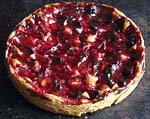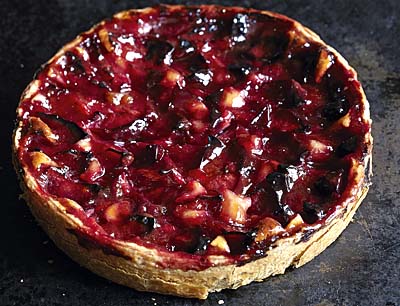Simon Hopkinson’s plum recipes
This year’s plums demand to be put into flasky pastry and baked, says Simon Hopkinson


Plum and almond tart Serves 4
If you happen to be in possession of one of those seriously nifty small electric food mills, then I urge you to grind your own almonds using whole, skinned nuts. I buy mine in bulk, then keep them in the freezer in sealed plastic bags to ensure freshness you can mill them directly from frozen, too. Ingredients
200g all-butter puff pastry A little softened butter For the almond cream 75g soft, salted butter 60g caster sugar 100g ground almonds (or the same weight, whole) 40g plain flour 1 large egg
5-6 Victoria plums A little extra caster sugar 2tbsp apricot jam, melted over heat with a trickle of water
Method
Pre-heat the oven to 190˚C/ gas mark 5, and also place a flat baking sheet on the middle shelf. Grease a (preferably) non-stick, 20cm loose-bottomed tart tin with a little butter. Roll out the pastry until quite thin, then neatly line the tart tin with it, leaving a definite overhang around the rim.
Lift this up with your fingers, crimping it together to form a raised edge; this will help to stop the pastry from shrinking too much below the filling of the tart as it bakes. Now, generously prick the base of the tart with the tines of a fork. Place in the fridge to rest and firm up, for about 30 minutes. Meanwhile, make the almond cream.
Exquisite houses, the beauty of Nature, and how to get the most from your life, straight to your inbox.
To create this, place the butter and sugar in a food processor and work until pale and thick. Tip in the almonds and flour, process together thoroughly, and then beat in the egg. Once all is thoroughly blended together and very smooth, scrape out into a small bowl and set aside at room temperature.
Cut the plums in half, remove the stone and cut them into quarters. Spread the almond cream into the pastry case and smooth the surface using a wet spatula or palette knife. Setting the plums at a jaunty angle, cut side up, arrange them on top of the cream. Begin at the top edge of the tart, placing them in a curved row, lightly pressing them into the cream, while working down towards the other side closest to you. The rows of plums will increase in length as you cover the tart, then decrease again as you finish it.
Sprinkle the plums with the merest dusting of caster sugar, then slide the tart onto the hot baking sheet. Bake for about 10 minutes, then reduce the heat to about 150˚C/gas mark 2 for a further 30 minutes, or until you can see that the almond cream has puffed up around the plums, is just firm to the touch and that the plums have become nicely burnished and, in places, even very slightly burnt.
Remove from the oven and leave to cool for 10 minutes before lifting out of the tin and placing onto a cooling rack. Finally, using a pastry brush, carefully glaze the surface of the tart with the melted apricot jam (sieve if necessary, to remove any lumps of fruit). Eat warm, or at room temperature, with thick cream.

Stewed plums and rice pudding Serves 4
Having found it increasingly difficult to obtain ‘pudding rice', I now use either a simple arborio or even carnaroli risotto rice to fashion a rice pudding. And, do you know, I have been pleasantly surprised by the excellent results. The pudding that you see in the accompanying picture was made with Riso Gallo's Gran Reserva carnaroli, and, if I may say so, it produced one of my most successful puds yet.
Also, in the past, I further favoured inserting a split whole vanilla pod into the rice as it cooked. Simply for the sake of ease, together with a desire to avoid the messy moment when it has to be removed, I now prefer to add a couple of teaspoons of pure vanilla extract. Most supermarkets now stock this in the baking section. The best brand is Madagascar Bourbon, in brown bottles. I find ‘essence' imparts a slightly chemical taste.
Ingredients
350g small plums 1 heaped tbsp caster sugar About 50ml water
For the pudding
40g butter 75g caster sugar 100g arborio/carnaroli rice 2tsp vanilla extract 1 litre full-cream milk 150ml double cream Pinch of salt Plenty of freshly grated nutmeg
Method
To stew the plums, simply pop them in a stainless-steel pan, add the sugar and water and carefully stir together. Quietly simmer over a low heat for about 15 minutes until the juices have nicely run out of the cooked fruit and produced a fine, scarlet syrup. Decant into a dish and leave to cool. Pre-heat the oven to 150˚C/ gas mark 2. Melt the butter in a solid-based, flameproof casserole and add the sugar.
Stir around and heat gently until gooey, then add the rice and continue stirring until the rice looks a touch puffed and sticky with sugar. Now, gently pour in the milk, which will seethe around the rice, causing the volatile rice/butter/sugar mixture to set into lumps at once. However, fear not, for as you stir around in this milky mess with the aid of a wooden spoon, within minutes, any sugary lumps will dissolve into the milk as it heats up.
Continuing to stir, add the vanilla, cream and salt, and bring the mixture to a simmer. Once this is reached, give the mixture a final stir and grate at least a third of a nutmeg over the surface (do not stir again). Pop in the oven and bake for about 60-90 minutes; if the surface burnishes too quickly, lay a loose sheet of foil over the pudding. Once there's a nice, thin, tarpaulin-like skin on the surface, and the pudding only just wobbles in the centre, it's ready; remember, the rice will continue cooking a little as the heat wanes. Serve at room temperature.
Simon Hopkinson is the founding chef and co-proprietor of Bibendum restaurant, London
** Save £1 per issue when you subscribe to Country Life
Country Life is unlike any other magazine: the only glossy weekly on the newsstand and the only magazine that has been guest-edited by His Majesty The King not once, but twice. It is a celebration of modern rural life and all its diverse joys and pleasures — that was first published in Queen Victoria's Diamond Jubilee year. Our eclectic mixture of witty and informative content — from the most up-to-date property news and commentary and a coveted glimpse inside some of the UK's best houses and gardens, to gardening, the arts and interior design, written by experts in their field — still cannot be found in print or online, anywhere else.
-
 An Alpine hideaway on a Swiss mountaintop that's like something from the pages of a Gothic novel
An Alpine hideaway on a Swiss mountaintop that's like something from the pages of a Gothic novelA wonderful Baroque castle set amid gardens and woodland is for sale in one of Switzerland's most beautiful areas.
-
 Robotic sharks, Egyptian mummies and a Rolls-Royce: Start your weekend with the Country Life Quiz of the Day
Robotic sharks, Egyptian mummies and a Rolls-Royce: Start your weekend with the Country Life Quiz of the DayYou will take the quiz, and you will learn things. That is my promise.
